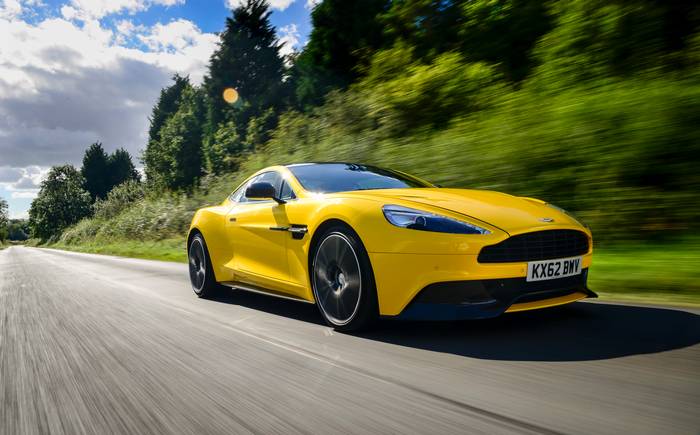The Clarkson review: Aston Martin Vanquish (2012)

I’m a fiddler. Whenever I get the furniture in a room arranged just as I like it, I sit down and decide immediately that I don’t like it at all. It all started in my study at school. I had to share it with five younger boys so that meant five tables and five chairs. And pretty much every day I’d try something a bit different.
Usually this meant four boys sharing one table and me having the others for my various hi-fi components that had to be laid out horizontally for aesthetic reasons one day and then vertically the next.
Search for and buy a Aston Martin Vanquish on driving.co.uk
I think, therefore, I’d make a good fist of running Aston Martin. It is a small company with limited resources and no big-boy owner to help out with the economies of scale when buying components. Bentley can get its masters at Volkswagen to make noises when negotiating a deal on a new supply of brakes. Rolls-Royce can turn to BMW. Ferrari can look to Fiat. But Aston has to go and see ZF, the German gearbox manufacturer, and say, “Please, sir, can we have some more?” And usually the answer is, “Nein, Englander”. So it has to produce a range of cars using nothing but what it’s got. And what it’s got is two engines. And one basic design.
It started with the DB9. An excellent, graceful and fast car. It heralded a departure for the company and many were sold. So a new car was launched, the V8 Vantage. To the untrained eye, it looked pretty similar to the DB9 but to start with, it had a different engine and was a bit more sporty. Then it was fitted with the same engine as the DB9. And then the DB9 was given some new sills to become the DBS, which was very brilliant but quite expensive. So some new sills were invented to create the Virage. And you could also buy most of these cars as convertibles or coupés. In essence, then, Aston’s engineers were in my study, endlessly rearranging the same bits of furniture.
And now they’ve rearranged them again. The DBS and the Virage are gone and in their place we have the car you see here. A car that doesn’t even get its own name. Instead they’ve rummaged around in the company tuck box and found an old moniker — Vanquish.
You may remember the first effort. I do. Mainly because it was so very poor. Yes, it had a big price tag and a big V12 engine — made from mating two Ford V6s together. And yes, it was very fast, but only in theory. In practice it went from 0 to 6000rpm in one clutch.
So the new car uses an old name and the same basic engine that’s been in the DB9, the DBS, the Virage and the V12 Vantage. The same basic styling, the same construction techniques and a six-speed automatic gearbox from ZF’s end-of-season everything-must-go discount bin. And the price tag for this rearrangement? Well, before you start with options, it’s a whopping £189,995.
There are other issues too. This is a car made from a clever, glued-together aluminium and carbon fibre tub. It has aluminium side-impact beams. It should be so light that it needs mooring ropes rather than a handbrake, to stop it floating away. And yet somehow it weighs more than 1.7 tons. Perhaps that’s why it’s so expensive — because the seats are filled with gold ingots.
On paper, then, this looks like a bubble-and-squeak car. At first appealing but when you stop and think, you realise you’re eating leftovers. And yet . . .
While the profile may be familiar, there is no doubting the fact that the styling tweaks are extremely successful. This is a car that moons you with its beauty. The new Ferrari F12 is good-looking enough to cause a grown man to faint but the Vanquish is better still. It’s delightful on the inside too. The old Volvo sat nav has been replaced with a system that tells you where you’re going rather than where you’ve been and the fiddly little buttons that plagued the short-sighted in previous models have been replaced with bigger “haptic feedback” knobs that buzz slightly when you touch them. Why? Not a clue, but it’s nice.
Thanks to a smaller transmission tunnel, there’s more space than in previous models too. So much, in fact, that if you specify the optional rear seats, you can actually put people in them. People with heads, if you want, and legs.
And then there’s the upholstery. It looks like leather bubble wrap and it’s wonderful. So when it comes to practicality — it even has a big boot — and styling, this car is world class. It’s an iPhone in a sea of Bakelite.
And there’s more. The engine is a masterpiece. You get almost 11% more power than you did from the DBS, and that means 565bhp. To remind you that they are there, all of them bark every time you go anywhere near the throttle.
It’s more than just the aural effect, though: it’s the sense that this engine is not a thousand parts whizzing about under the watchful eye of an electronic overlord. It feels like one big muscle — a mountain of loud but lazy torque.
Normally I worry about V12s. I always fear that a V8 does pretty much the same job with much less complexity and much less opportunity to go wrong. But the V12 in the Vanquish is a thing of such unparalleled brilliance, I’d be prepared to forgo my worries.
It suits the gearbox too. Yes, almost all of the Vanquish’s rivals are now fitted with eight-speed manual gearboxes that are operated by flappy paddles. This is very good for the environment, as they use less fuel, and it’s also good when you are on a racetrack. But it’s not so good when you are in town and you have a millionth of a second to exploit a gap in the traffic. Because at low speeds they are dimwitted, jerky and hesitant.
That’s where the Aston scores. Yes, it has flappy paddles but they are connected to an automatic gearbox. That may be old-fashioned but in town it works much, much better.
But, you may be wondering, what about out of town? Can the bubble-and-squeak car really hold its own against its more modern rivals? The short answer is no. You feel the weight and that makes the car feel bigger and more intimidating than it really is. It doesn’t flow and it doesn’t really matter whether you engage Sport mode or put the suspension in Nutter Bastard mode, the Vanquish doesn’t boggle the mind quite as effectively as, say, a McLaren MP4-12C or a Ferrari California. It doesn’t feel special.
However, since it was a pre-production car, it’s probably unfair to say its boot lid broke and its passenger-side electric window was wonky.
If we assume these issues are addressed before the car goes on sale — that was never a certainty with Aston Martin in the past — then what do we have here? Well, it’s a thing of immense beauty and it does have a fabulous engine. In many ways you could call it a modern-day British take on the muscle car idea. And that would be great.
But I fear Aston is at the point where we can all see this car for what it really is. A new car that’s not really new at all.
Verdict ★★★☆☆
One reshuffle too many.
Factfile
Aston Martin Vanquish
- Price:
- £189,995
- Engine:
- 5935cc, V12
- Power:
- 565bhp @ 6750rpm
- Torque:
- 457 lb ft @ 5500rpm
- Transmission:
- 457 lb ft @ 5500rpm
- Acceleration:
- 0-62mph: 4.1sec
- Top Speed:
- 183mph
- Fuel:
- 19.6mpg (combined)
- CO2:
- 335g/km
- Road Tax Band:
- M (£1,030 for the first year)
- Dimensions:
- L 4720mm W 1912mm H 1294
Search for and buy a Aston Martin Vanquish on driving.co.uk





